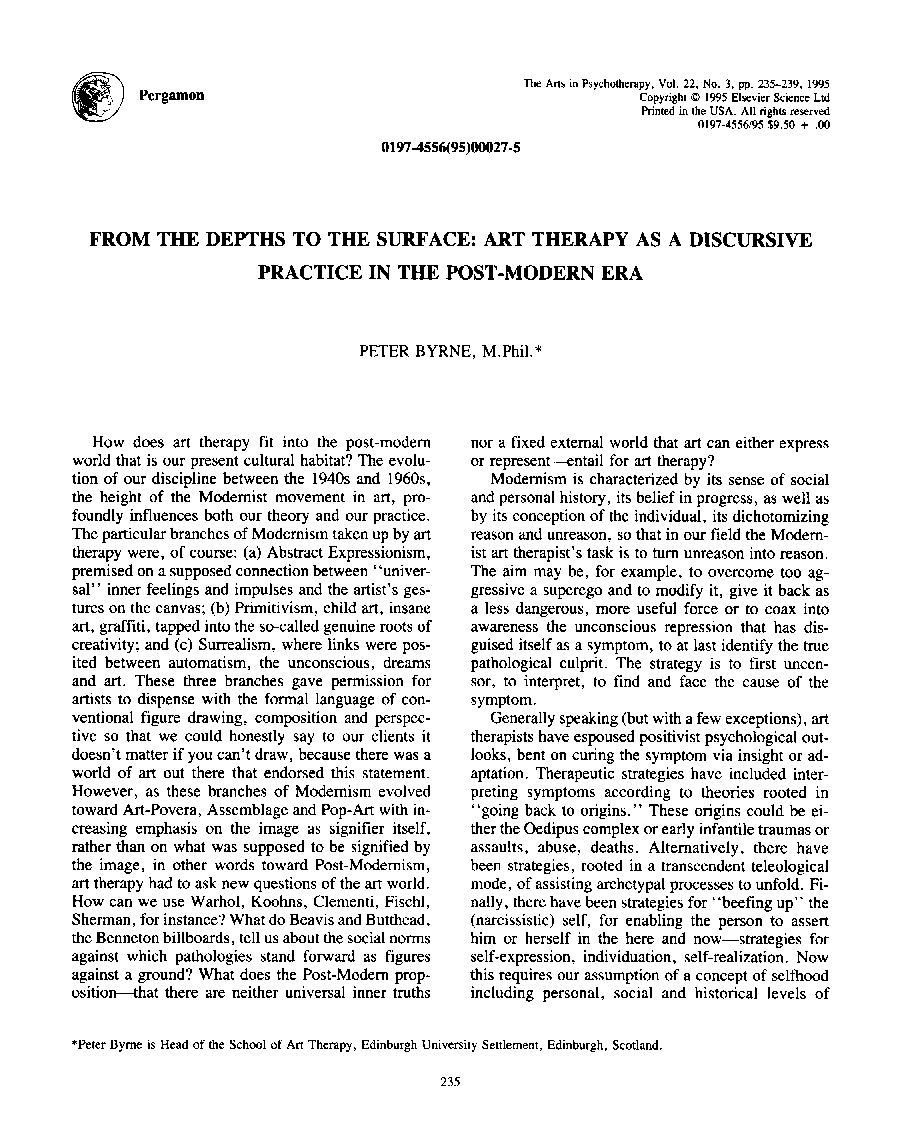Pergamon
The
Arts
in
Psychotherapy,
Vol.
22,
No.
3,
pp.
235-239.
1995
Copyright
0
1995
Elsevier
Science
Ltd
Printed
in
the
USA.
All
rights
reserved
0197-4556/95
$9.50
+
Ml
0197-4556(95)00027-5
FROM
THE
DEPTHS
TO
THE
SURFACE:
ART
THERAPY
AS
A
DISCURSIVE
PRACTICE
IN
THE
POST-MODERN
ERA
PETER
BYRNE,
M.Phil.*
How
does
art
therapy
fit
into
the
post-modem
world
that
is
our
present
cultural
habitat?
The
evolu-
tion
of
our
discipline
between
the
1940s
and
196Os,
the
height
of
the
Modernist
movement
in
art,
pro-
foundly
influences
both
our
theory
and
our
practice.
The
particular
branches
of
Modernism
taken
up
by
art
therapy
were,
of
course:
(a)
Abstract
Expressionism,
premised
on
a
supposed
connection
between
“univer-
sal”
inner
feelings
and
impulses
and
the
artist’s
ges-
tures
on
the
canvas;
(b)
Primitivism,
child
art,
insane
art,
graffiti,
tapped
into
the
so-called
genuine
roots
of
creativity;
and
(c)
Surrealism,
where
links
were
pos-
ited
between
automatism,
the
unconscious,
dreams
and
art.
These
three
branches
gave
permission
for
artists
to
dispense
with
the
formal
language
of
con-
ventional
figure
drawing,
composition
and
perspec-
tive
so
that
we
could
honestly
say
to
our
clients
it
doesn’t
matter
if
you
can’t
draw,
because
there
was
a
world
of
art
out
there
that
endorsed
this
statement.
However,
as
these
branches
of
Modernism
evolved
toward
Art-Povera,
Assemblage
and
Pop-Art
with
in-
creasing
emphasis
on
the
image
as
signifier
itself,
rather
than
on
what
was
supposed
to
be
signified
by
the
image,
in
other
words
toward
Post-Modernism,
art
therapy
had
to
ask
new
questions
of
the
art
world.
How
can
we
use
Warhol,
Koohns,
Clementi,
Fischl,
Sherman,
for
instance?
What
do
Beavis
and
Butthead,
the
Benneton
billboards,
tell
us
about
the
social
norms
against
which
pathologies
stand
forward
as
figures
against
a
ground?
What
does
the
Post-Modem
prop-
osition-that
there
are
neither
universal
inner
truths
nor
a
fixed
external
world
that
art
can
either
express
or
represent--entail
for
art
therapy?
Modernism
is
characterized
by
its
sense
of
social
and
personal
history,
its
belief
in
progress,
as
well
as
by
its
conception
of
the
individual,
its
dichotomizing
reason
and
unreason,
so
that
in
our
field
the
Modem-
ist
art
therapist’s
task
is
to
turn
unreason
into
reason.
The
aim
may
be,
for
example,
to
overcome
too
ag-
gressive
a
superego
and
to
modify
it,
give
it
back
as
a
less
dangerous,
more
useful
force
or
to
coax
into
awareness
the
unconscious
repression
that
has
dis-
guised
itself
as
a
symptom,
to
at
last
identify
the
true
pathological
culprit.
The
strategy
is
to
first
uncen-
sor,
to
interpret,
to
find
and
face
the
cause
of
the
symptom.
Generally
speaking
(but
with
a
few
exceptions),
art
therapists
have
espoused
positivist
psychological
out-
looks,
bent
on
curing
the
symptom
via
insight
or
ad-
aptation.
Therapeutic
strategies
have
included
inter-
preting
symptoms
according
to
theories
rooted
in
“going
back
to
origins.”
These
origins
could
be
ei-
ther
the
Oedipus
complex
or
early
infantile
traumas
or
assaults,
abuse,
deaths.
Alternatively,
there
have
been
strategies,
rooted
in
a
transcendent
teleological
mode,
of
assisting
archetypal
processes
to
unfold.
Fi-
nally,
there
have
been
strategies
for
“beefing
up”
the
(narcissistic)
self,
for
enabling
the
person
to
assert
him
or
herself
in
the
here
and
now-strategies
for
self-expression,
individuation,
self-realization.
Now
this
requires
our
assumption
of
a
concept
of
selfhood
including
personal,
social
and
historical
levels
of
*Peter
Byrne
is
Head
of
the
School
of
Art
Therapy,
Edinburgh
University
Settlement,
Edinburgh,
Scotland.
235


